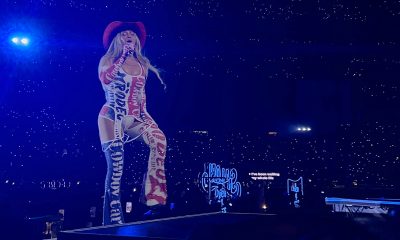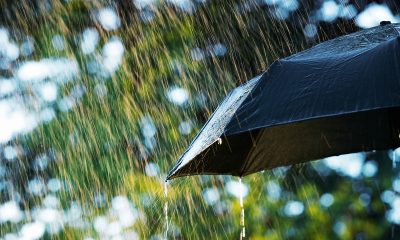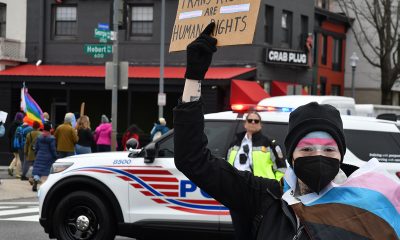a&e features
Lily Tomlin on why she’s happy she lost the Emmy this year — and a whole lot more
Comedy legend on Fonda, Travolta, Madeline Kahn, Gilda Radner and her nearly 50-year career
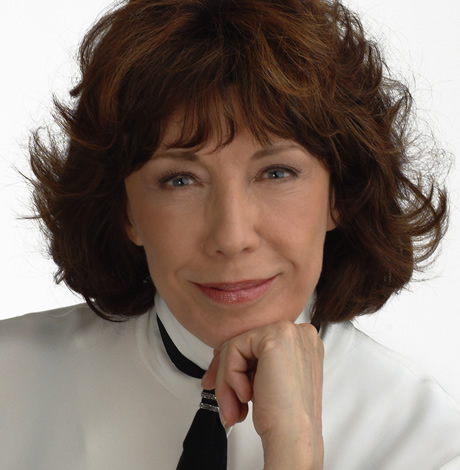
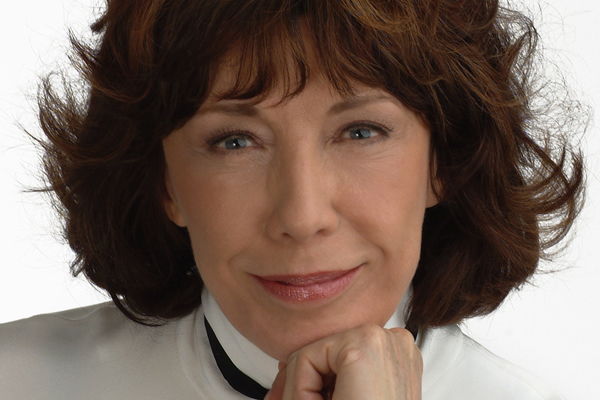
Lily Tomlin says her comedy was too ‘off the wall’ for a ‘Carol Burnett Show’-type series in the ‘70s. (Photo courtesy Tomlin)
Lily Tomlin
Wednesday, Oct. 17
8 p.m.
Kennedy Center Concert Hall
2700 F St., N.W.
$39-129
It’s Tuesday, Sept. 18, the morning after the Emmy Awards. Lily Tomlin was nominated for her role as Frankie on “Grace and Frankie,” her hit Netflix comedy in which she co-stars with her old pal Jane Fonda. By phone from her home in Los Angeles, Tomlin is thoroughly unfazed at having lost to Rachel Brosnahan for Amazon’s “The Marvelous Mrs. Maisel.”
Tomlin, 79, has seven other Emmys and is only an Oscar short of EGOT status. She spent a delightful near-hour with the Blade by phone — ostensibly to talk about her Oct. 17 show at the Kennedy Center though she was far more animated on a host of other topics. Her comments have been slightly edited for length.
WASHINGTON BLADE: How were the Emmys?
LILY TOMLIN: Well I was a little bit late. I missed the opening number and then my category was announced and I went backstage to the green room to congratulate Brosnahan. … She was very sweet and everything like that. Then out in the hallway I ran into Betty White so we took a photo. She’s totally charming. Her birthday is Capricorn so she’s very much like my mom and she could be my mom, that’s what’s staggering.
BLADE: Was there anybody else you were particularly rooting for?
TOMLIN: Not so much. I don’t want to be blase about the Emmys but there’s so much product, I mean there’s no way they can embrace all the product. There’s something like 450 shows on the air probably that run every week at least part of the year. That’s just staggering.
BLADE: Do you watch many of them?
TOMLIN: I only watch an infinitesimal fraction of them. I watch all the obvious ones, you know. “Ozark,” that’s sort of a creeper. When “Homeland’s” on I watch “Homeland.” “Billions.” I used to watch “Orange is the New Black” but I sort of got — well, you lose track of it. A new show comes along and you start watching that for a season or two then you gotta double back and see way into some other show you loved and it’s just too much. There’s no way any one person could watch all the shows for a whole year, never mind having to earn a living or anything.
BLADE: I don’t even know how the critics do it.
TOMLIN: I don’t even know if they do do it. I think they just run through one or two and they take a little consensus. I don’t think they can do it. Maybe somebody has laid out the statistics so they know that golly, it is possible but I’d be more hard pressed I guess. (laughs)
BLADE: Do you dream of winning the Oscar to complete the set?
TOMLIN: I think I probably have missed that chance.
BLADE: Well you never know.
TOMLIN: No, you never do know but as you get older, it’s very hard to come by older parts. And of course I have that idea alive but by that time it’s not gonna matter. It’s getting ridiculous. There was a time when everybody was focused on somebody coming along and, “Oh, she’s got an EGOT.” I’ve satisfied myself because I have two Peabodys. I said, “Well, if I did have an Oscar, I’d have a PEGOT. I wonder how many more people have a PEGOT.” (laughs)
BLADE: Probably none.
TOMLIN: Maybe, I don’t know. But it’s like all things in life. It’s not that it’s not exciting or fun or you value it or you’d like to win but frankly, I did not want to win last night. I didn’t want to win when Jane Fonda wasn’t nominated. So when she was nominated we’d go to the Emmys together and we’d feel pretty satisfied we weren’t gonna be called to the front because we knew we’d split the vote. You never really know. You don’t know what the count is, but I didn’t relish winning and plus I feel a little bit somewhat estranged from the multitude of shows that are on. I used to have friends on every show or I’d really be able to grasp the whole industry in an armload but times change. The Emmys will probably eventually evolve into something else. I’ve been a governor at the Academy and it’s a very hard thing to do. You have to have someone who has the brains to figure out what’s coming down the pike and how they should handle it. I think time will just take care of that.
BLADE: Are you still shooting season five?
TOMLIN: No, we finished that and we’re gonna start season six in January so we’re chugging along. We really do love doing the show.
BLADE: How long does it take to shoot a season?
TOMLIN: Four-five months but we have a little time. We put some hiatuses in there and we really like that. So we’ll work like three-four weeks and have a week off. And as time has gone on, the other characters, their lives have gotten more developed and so it used to be very heavy on the shoulders of Jane and me to handle the story because they had to establish our characters strongly first and now everybody else has a life going on and there’s a lot of interaction now so we’re able to have this time off. We just have fun, that’s all. I adore Sam (Waterston) and Martin (Sheen) and my kids. I even love Jane’s kids.
BLADE: Critics have said the show found its footing more in the second and third seasons. Would you agree?
TOMLIN: Yeah, I guess we found it as we went along because whoever was gonna develop that story, they were finding it too. I don’t think anybody had that story thought out completely. I don’t think any show ever does. It evolves as you go along. When I did “Damages” on FX, it was exciting because we were playing such bad people. We were always getting into some dreadful mischief. It was based on the Madoff family and we never knew how bad we were and they never told us. So we would sort of play it by ear. … We’d stand around and we were always having to play both sides of the road because we were hoping we were gonna be really bad. We’d stand around and say, “Do you think Joe would kill his mother, do you think she would kill her son …” (laughs) We were just really deep into it. So with “Grace and Frankie,” especially the beginning season, we had to adjust how we all behaved. … Like that scene on the beach when Jane and I are doing peyote and we’d sort of hit bottom with our husbands taking off and all that. When we played that one scene where she’s saying, “You know, why aren’t you mad and upset,” and all that stuff, and I’d say, “No, he didn’t know what he was doing, he couldn’t do it any other way and that’s all he could do,” and then she’d say, “How can you just take it” or something like that and then I broke down and said, “I’m heartbroken.” I didn’t really expect that.
BLADE: What’s it like working with Jane now versus 30 years ago? Has she mellowed or not mellowed or anything noticeably like that?
TOMLIN: I feel like she’s the same person. She’s always growing and always learning and changing and developing herself and trying to make everything better so I don’t even want to say she hasn’t changed because I’m sure she has changed for the better in many ways but I can’t just put my finger on it because she’s a really good person. Even when she’s being really direct, it’s because she wants to make things better for everbody. Like she’ll say to someone on the set, “You need a haircut.” Somebody else would just be devastated if somebody of Jane’s position on the show should go in and tell somebody that but sure enough, the person would go in and somebody would cut their hair and they’d look really great and it was just like she has an eye for it and she can’t help being that direct. It’s like, “God, we gotta fix this right now,” but never in a hurtful way. She’s really a wonderful friend to me.
BLADE: Are you in “Jane Fonda in Five Acts,” her new documentary?
TOMLIN: I’m in it briefly in the beginning and then a little bit in the middle someplace.
BLADE: Have you seen it yet?
TOMLIN: Yeah, we had a big screening and then Jane and I went up to San Francisco the next morning to lobby for one fair wage and we didn’t get home til midnight that night so we were beat. We had the movie until 10:30, 11 or so then we had to be up and out of the house by 7 so sometimes we’re just doing so much, we’re on the run all the time.
BLADE: How did you like it?
TOMLIN: I liked it. I thought it was rather epic. She has lived such a full life.
BLADE: How has Netflix been to work for?
TOMLIN: Netflix is great. It’s good. It’s good except we don’t know how successful we are. Our agents don’t even know. They just know it’s popular.
BLADE: So there’s no ratings or any way to gauge it?
TOMLIN: No, you never really know. It’s not like being on network and knowing you’re number whatever in a roster and you know how much the network wants to keep you or not keep you. It can work two ways. It can make you feel very familial with the boss man or it can make you rebel.
BLADE: Well you never know what kind of footing you’re on.
TOMLIN: Yeah, exactly. But they’re basically fun and the people at Netflix and Skydance, which is the producing partner of Okay Goodnight!, which is Marta Kauffman’s company, they all have a hand in it.
BLADE: How long would you like to see “Grace and Frankie” run?
TOMLIN: I think about eight years. Jane says she wants it to run until we’re both really old and everybody watches us age. I think that would be a good touchstone for people.
BLADE: Do you think sitcoms tend to run out of gas after about eight or 10 years?
TOMLIN: You mean the content?
BLADE: Yeah. It gets repetitious.
TOMLIN: Well I don’t know, we haven’t done it. Did “Seinfeld” run out? They were on nine years or something like that I think. “Murphy (Brown)” was 10 years.
BLADE: Are you gonna be on the reboot of that? (Tomlin played Kay on seasons nine-10)
TOMLIN: No, there’s no plans for me to be.
BLADE: What do you think of all these reboots? Is it a good thing or just a sign that they’re desperate for something with built-in name recognition?
TOMLIN: Well as with anything, it depends what’s done with it, who’s hand is in it. Is it innovative? Is it fresh? Can they find a freshness in those relationships? Now “Murphy” has a good chance because they’re gonna be very political and I think Candice’s character is very timely in that she has always been an independent woman. She’s assertive, she’s in a very timely, professional field and it’s been a long time since they’ve been on. Twenty years or more, maybe more.
BLADE: I read that “Grandma” was shot in just 19 days. Was it nerve wracking shooting that quickly?
TOMLIN: No, no it was great. The actors were so good and I adored (director) Paul Weitz. I’d done “Admission” with him and then he came back to me with “Grandma” and no, it wasn’t nerve wracking at all. It was rather fun. I thought that would be my last crack at an Oscar. I got a lot of great notices in the New York Times, the Los Angeles Times and all those papers but it just never took off. It was never a big enough hit to attract attention, maybe because of the subject, I don’t know. But I liked that little film very much.
BLADE: That was a decent hit relative to its budget. It must be quite gratifying to still be having hits with that and “Grace and Frankie.”
TOMLIN: Yeah, no of course it is. (laughs) Anything is fun that keeps you in the game.
BLADE: How did you get so chummy with (British cabaret singer) Mabel Mercer (1900-1984)?
TOMLIN: Oh Mabel Mercer, now you’re taking me back so far. Well what happened is I used to work at Upstairs at the Downstairs. I was in a revue there initially with Dixie Carter and Madeline Kahn and Irv Haber who owned the club, Mabel Mercer used to do Mabel’s Room downstairs which was this small little blot kind of room and it was just ideal for her and it used to be her room. Joan Rivers came along and made a huge splash and she was there on weekends and Mabel would come in like Mondays, Tuesdays and Wednesdays so Irv asked me to open for her. I had gone to see her in the old days when she was playing like, oh, what was it, the Bonsoirs or whatever that club was on 8th Street. My friend Louis and I would walk down there and we’d have like a quarter for the coat check and that would be it. The bar would be stacked so thick, you could stand there for a whole set and never even buy a drink. So when Irv gave me the chance to open for her, I just jumped at it. I think I was a little radical for Mabel’s crowd at the time. There’d be a lot of stars there at the late shows and I remember (‘30s actress) Patsy Kelly was one of the women and they were like of another generation. They were kind of very mouthy and loquacious and they’d speak out and catch you in all kinds of stuff. I used to do a funeral sketch where I’d use a ventriloquist dummy as the corpse to cheer up the crowd and Patsy jumps up and says, “OK, that’s enough of that, we don’t need to see that.” They didn’t like that subject and of course maybe as you get closer to death you don’t. So I lived in Yonkers and I’d go pick Mabel up in Harlem. She stayed there with relatives because she lived in Rockland County and I would go pick her up in Harlem and we’d drive to the club and then I’d take her back to Yonkers and having those times with Mabel Mercer was so fabulous. She was so wonderful, so human, so elegant and so down to earth. One time she said to me, “You know, Lily — I would just love to get a commercial.” And this was a time when we didn’t really do commercials, not those of us who had any consciousness. We thought it was terrible that these big companies would co-opt artists into their commercial activities but she had a girlfriend who’d gotten a Tide commercial and bought herself a fur coat and she thought that was great. I loved her so much. I used to go to Cleo’s and different clubs around New York and she would make me cry so much. Laugh and then cry at the way she could interpret a song. She had no voice left really. Her voice was very limited but she was so brilliant and she would be so moving and entertaining. I cried into napkins then glued them into my scrapbook. I need to go over to the office and see if I still have all that stuff.
BLADE: Were you close to Madeline and Dixie?
TOMLIN: I was closer to Madeline. … They’re both dead now and it’s just terrible. Madeline especially died really early. Anyway as Ruth Draper would say, “Well, that’s that.”
BLADE: You grew up in a mostly black neighborhood in Detroit. Did you know or know of Aretha and Smokey and all those folks?
TOMLIN: I was but I didn’t know them personally. I knew of them. I knew of Motown and I knew of everything but I didn’t really know them. I later met Diana Ross and she introduced me to Michael Jackson. He was really quite a kid but I didn’t really hang with them. They wren’t within like a two- or three-block radius of the apartment house I lived in.
BLADE: With all those TV specials you did in the ‘70s, was there ever talk of you having your own variety show?
TOMLIN: Well all those specials were supposed to be pilots for variety shows. I did six of them — four for CBS and two for ABC and I had huge ratings, especially for the first couple. The second special I did for CBS, Freddie Silverman wasn’t going to air it. He screamed at my manager Irene, “He said this $360,000 — they only cost $360,000 in those days — jerk-off.” Then he had breakfast with Alan Alda, and Alan Alda was on it, and he said, “Oh, I just had the greatest time doing Lily Tomlin’s special,” and Fred Silverman went back and looked at it again and he relented and they put it on at 10 o’clock that night and we got two Emmys, best special and best writing.
BLADE: Why do you think they never got picked up?
TOMLIN: It was unusual for its time and that was the last gasp of variety shows until something like “Saturday Night Live” comes along and “Fridays.” “Fridays” was a fairly successful show too. … You can’t predict a lot of this stuff. My shows were just too off the wall basically at that time but they weren’t off the wall, they were right on the wall. They were really good, most of them. When they didn’t really interfere with us, we’d go haywire.
BLADE: Jane says the “9 to 5” sequel is a go. What’s the status of that?
TOMLIN: It’s being written. Then we’ll have our input but we can only wait for the first draft and see how that goes. But they want it quite badly so I think they’ll keep working on it til it’s greenlighted.
BLADE: It’s so many years later. Was there serious talk of doing something sooner?
TOMLIN: There was constant talk of it. Before (director) Colin (Higgins) died, he had written a draft that would have starred Jane, Dolly (Parton) and me. Now we’ll be paired with a younger generation although we’ll figure prominently in the story but there’ll be other aspects of the story that would not have been present if we’d done it immediately after the original. At one point, Jada Pinkett Smith optioned it and they were gonna do it with an all-black cast. That never came to fruition and Jane Fonda had given up the rights in some fashion so she didn’t even have control of it at that time. Now it’s come back around to us again.
BLADE: Does performing at the Kennedy Center have any special resonance for you since you have the Honors and the Twain Prize or is it just like performing anywhere else?
TOMLIN: Well the last time I was there, I did “The Search for Signs of Intelligent Life in the Universe,” so I’m not doing that show at the moment but I’m doing something character driven. I use some video, mostly to make fun of myself or to reflect on a character’s development from many years before. I like to think of my act as a roller coaster ride and you never know when that drop is gonna come. I just like to keep things mixed up.
BLADE: Does Ernestine have anything to say about the current administration?
TOMLIN: She probably has plenty to say but she won’t be saying it this evening. I don’t think she will. Unless she and Trump get into a Tweeting war (laughs).
BLADE: Did you and John Travolta hit it off making “Moment by Moment” (1978)?
TOMLIN: Yeah. He could do my characters, especially Trudy the bag lady. He was a darling guy. I loved him a lot. He was really cute, really sweet. Only about 23 or something.
BLADE: Have you seen him recently?
TOMLIN: Yeah, I’ve run into him. I’ve seen him at the theater or at award shows, especially when he was doing O.J. Oh, who did he play? He was very good. He’s a good actor. He sent me a congratulations on my Emmy nomination.
BLADE: How is (your wife) Jane (Wagner) these days? What’s she up to?
TOMLIN: She’s wonderful, terrific, fabulous.
BLADE: Does she enjoy being more behind the scenes?
TOMLIN: I think she does prefer that. She’s much more introspective than I am. But, you know, if she does something she likes to be acknowledged for it. We’ve tried hard to do that over the years. I used to have to write to Ted Koppel. He used to say, “As Lily Tomlin says …,” during the tenure of “Search,” there were so many great lines in “Search,” and it was true, I did say it but Jane wrote it. I’d say, “Ted, you’ve got to acknowledge Jane for this line.”
BLADE: Are you working on anything together now?
TOMLIN: We’re mostly working on producing stuff. We’re working on a show on the pulp novels of the ‘50s. I don’t know if you know them or not, but Ann Bannon’s books about Beebo Brinker who is a lesbian in the Village in the ‘50s and early ‘60s.
BLADE: Where would one have purchased those books then?
TOMLIN: You’d get ‘em off a low grade news stand or in a little kiosk that wasn’t in your home town. It was always kind of furtive. God forbid somebody would see one in a drawer in your house or something.
BLADE: Were they as kitschy at the time as they seem now?
TOMLIN: No, they weren’t.
BLADE: They seem like total kitsch now.
TOMLIN: Yeah, they’re pretty kitschy but they were rather heart felt. We’re trying to make a series of it.
BLADE: Will it be cheeky or straight?
TOMLIN: Well I think it may be in the eye of the beholder.
BLADE: What do you like to do when you have a day off at home? Do you like to piddle around the house and cook?
TOMLIN: Yeah, I like to be at home. I have Cancer rising so my home is important to me. I have an Aries moon, so I’m volatile. Then I have a Virgo sun, if all this stuff is true and applicable.
BLADE: Did you see the new Gilda (Radner) documentary?
TOMLIN: No. Someone sent me a notice to go to a screening but I had to work that night but I’m really anxious to see it. Gilda was so dear. She was a little bit younger and whereas I was good friends with Madeline and Dixie, I never really got to be close to Gilda except we were both from Detroit and I was on “Saturday Night Live” a few times.
BLADE: It’s nice to see her getting some dues a little bit with this.
TOMLIN: Oh yeah. None of the girls on “SNL” really got any kind of real celebration. The guys went on to make movie after movie and it didn’t even matter how they did. They always had one in the can, one in the planning and one on the boards so it one was failing, they always had two more chances. Gilda never really had any great vehicle written for her or anything like that.
BLADE: Thank you.
TOMLIN: Wow, you were pretty Johnny on the questions spot. I hope I gave you something to work with.
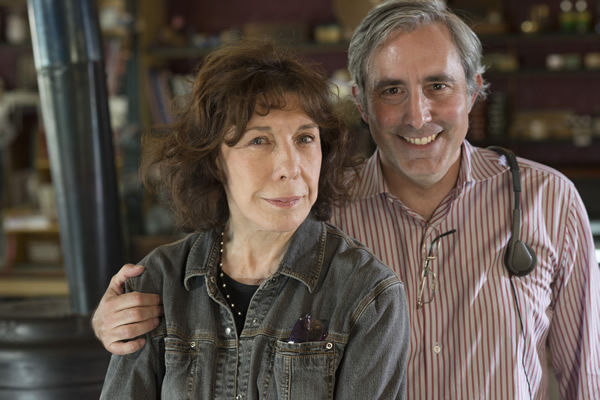
Lily Tomlin with Paul Weitz on the set of her hit 2015 movie ‘Grandma.’ (Photo by Glen Wilson; courtesy Sony Pictures Classics)
a&e features
Local, last-minute holiday gift ideas
Celebrate the season while supporting area businesses
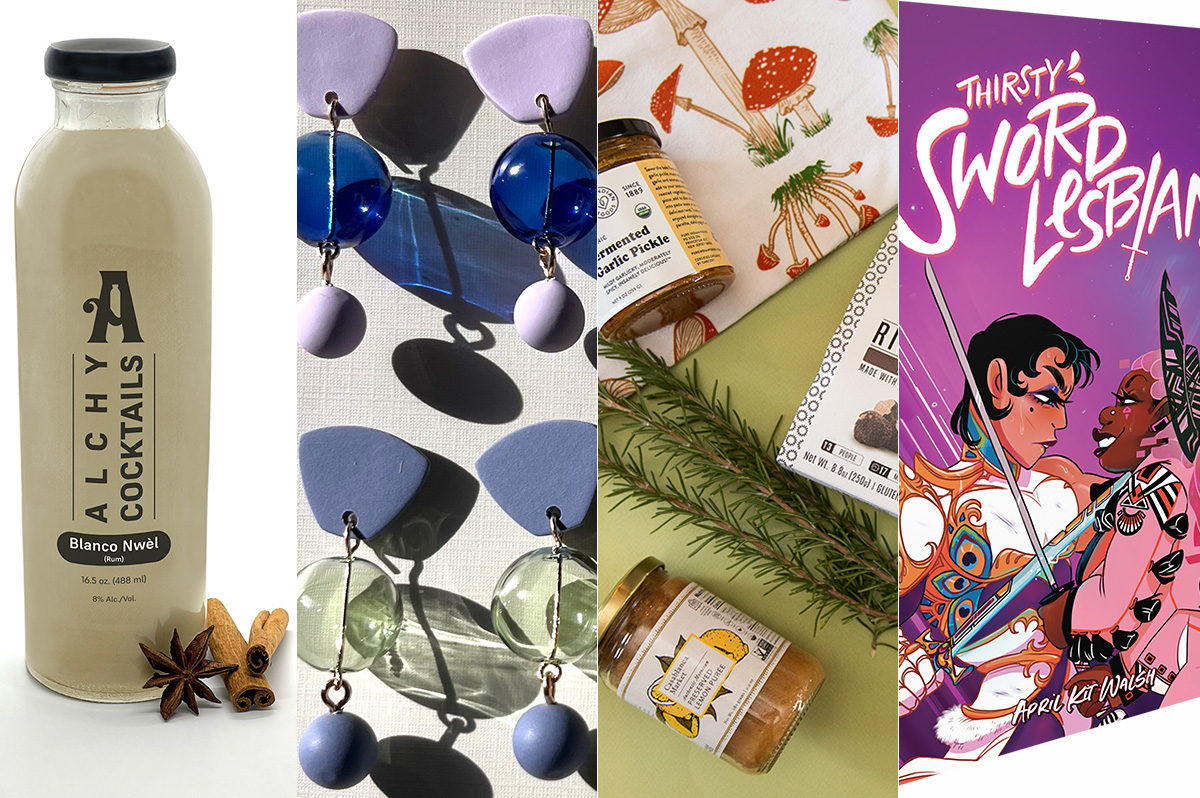
The DowntownDC Holiday Market is bustling. Union Station is decked out with its annual Christmas tree. Washingtonians have wrapped their houses and apartment balconies with festive lights and holiday decorations. The holiday season is here. And with stockings to fill and empty space under the tree, Washington’s local shops and artists have plenty to offer.
Show your LGBTQ and D.C. pride with the Washington Blade’s annual holiday gift guide.
To embrace the holiday buzz: The Blanco Nwèl cocktail from Alchy Cocktails. This Caribbean eggnog is one of Alchy Cocktail’s seasonal holiday cocktails. The flavor profile is similar to coquito, a traditional Puerto Rican Christmas drink with a coconut base. As a queer and Caribbean-owned business, Alchy Cocktails has been based out of Washington since 2021. Blanco Nwèl is available in both cocktail ($24) and mocktail ($12) online and at a variety of holiday markets, including the Tingey Plaza Holiday Market, the Flea Market at Eastern Market, Union Station’s Main Hall Holiday Market, and more. ($24)
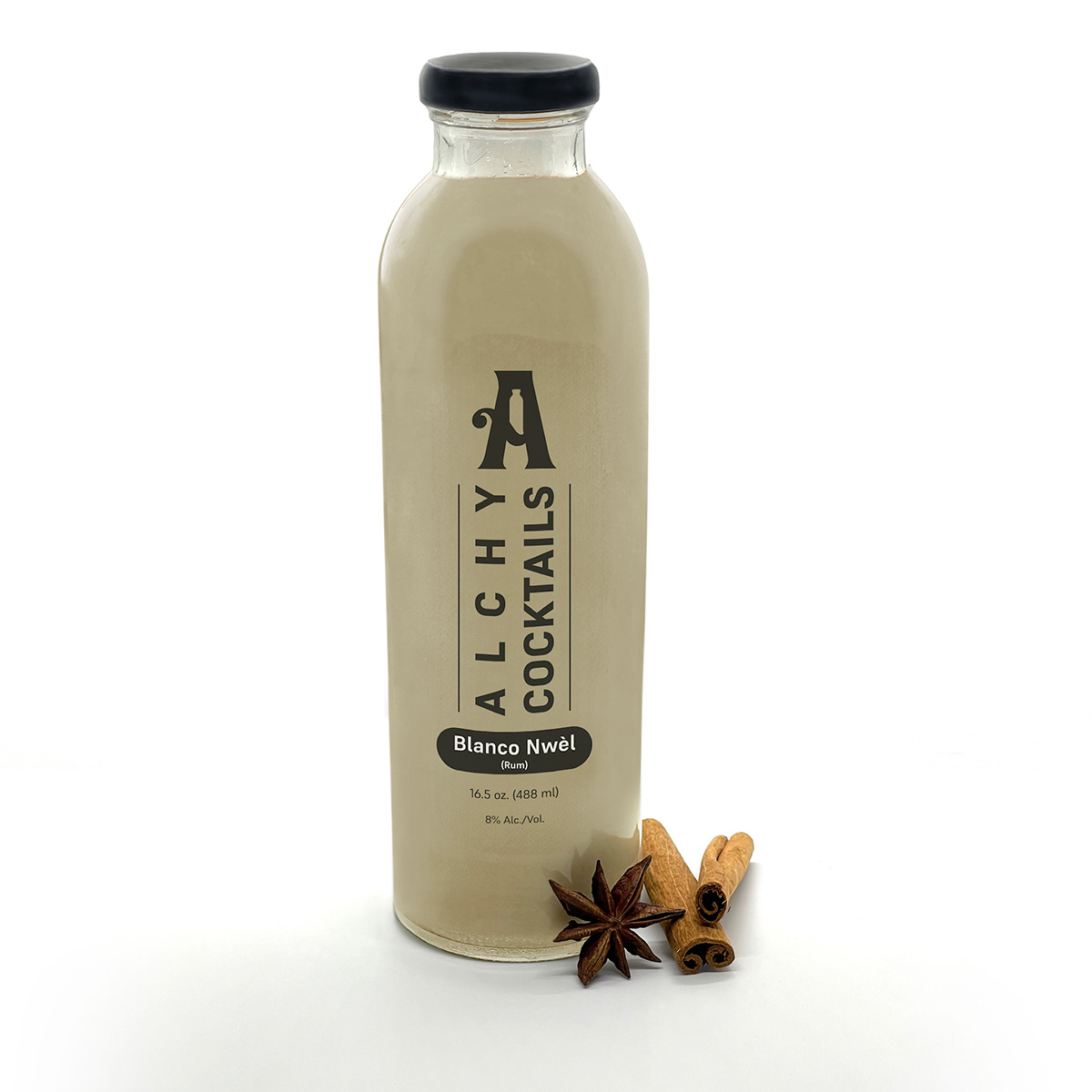
A spicy bite: Gordy’s Cajun Okra from Salt and Sundry. These spicy, tangy pickles pull on Southern Cajun-style flavors, packing a punch with paprika, cayenne, and more. Gordy’s is an LGBTQ-owned and Washington-based brand, making this gift an opportunity to support a local LGBTQ business straight from the jar. This pantry staple is available on Salt & Sundry’s website and at its locations in Union Market, Logan Circle, and its Georgetown holiday pop-up store. ($14)
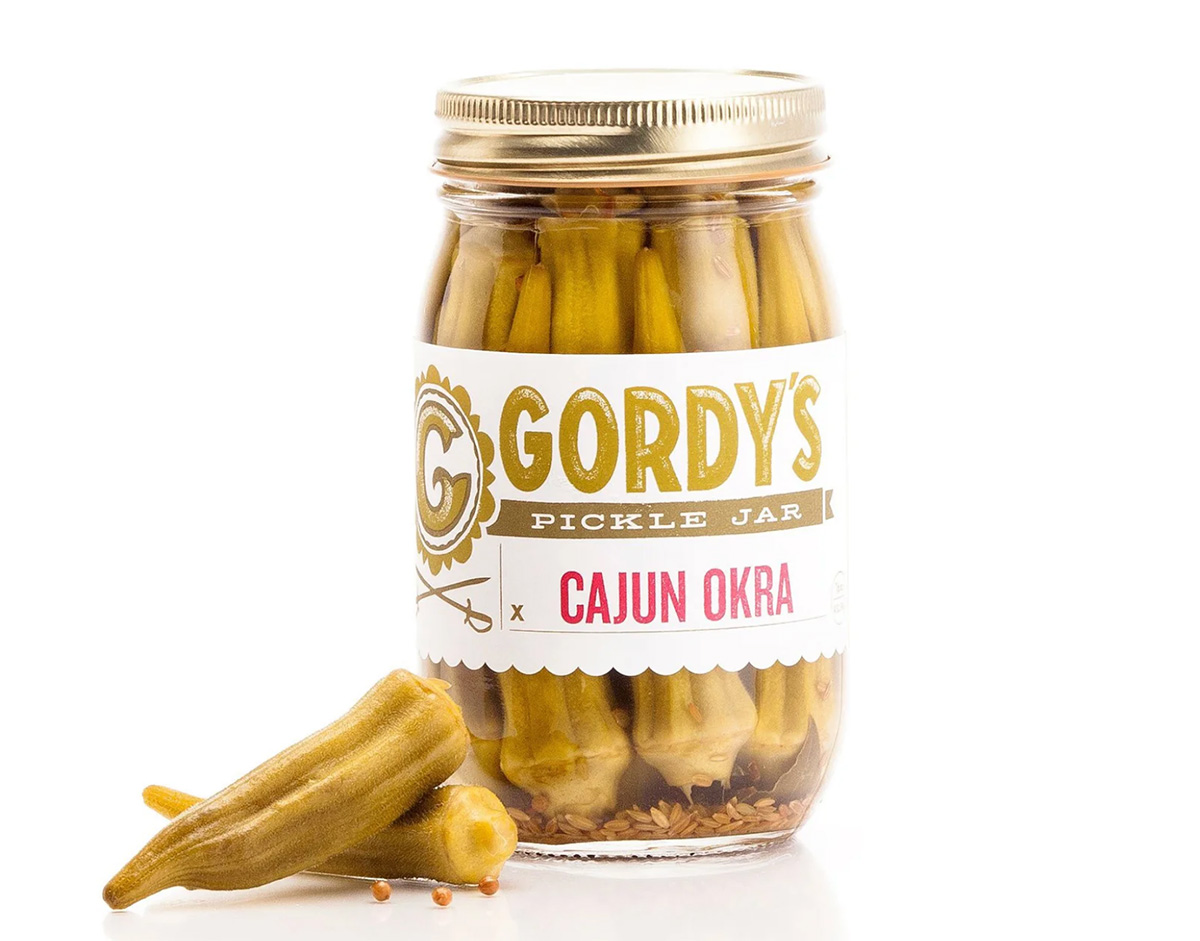
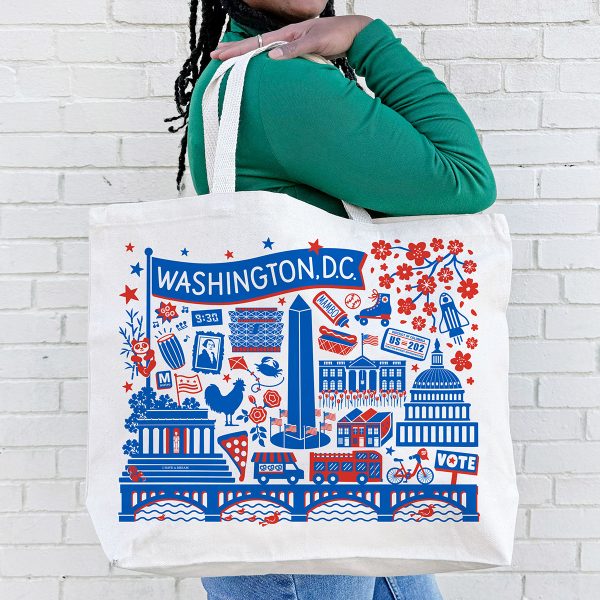
To celebrate Washington pride: The DC Landmark Tote Bag from The Neighborgoods. Native Washingtonians, visitors, friends and family alike will find something to love about this Washington-themed tote bag. Food trucks, the 9:30 Club, the Metro logo and pandas from the National Zoo are just some of the city’s landmarks depicted across the tote in a red, white, and blue color palette. The tote is a part of the DC Landmarks collection, which donates 10 percent of its sales to the American Civil Liberties Union. The Neighborgoods itself is a local, woman-owned business built out of a passion for screen-printing in 2013. The 100 percent cotton canvas tote is for sale online or at the DowntownDC Holiday Market. ($22)
To give friends and family their flowers: The Flowers Bandana from All Very Goods. This 100 percent cotton bandana was designed in Washington and hand printed in India. Its uniqueness comes in being covered with the faces of Black women, representing a “love letter to all women but especially Black women,” according to All Very Goods. The Black woman-owned and operated business, based out of Northwest Washington, has a mission to celebrate diversity and representation through its products. The bandana intends to give Black women their “flowers.” The Flowers bandana is available for purchase online. ($24)
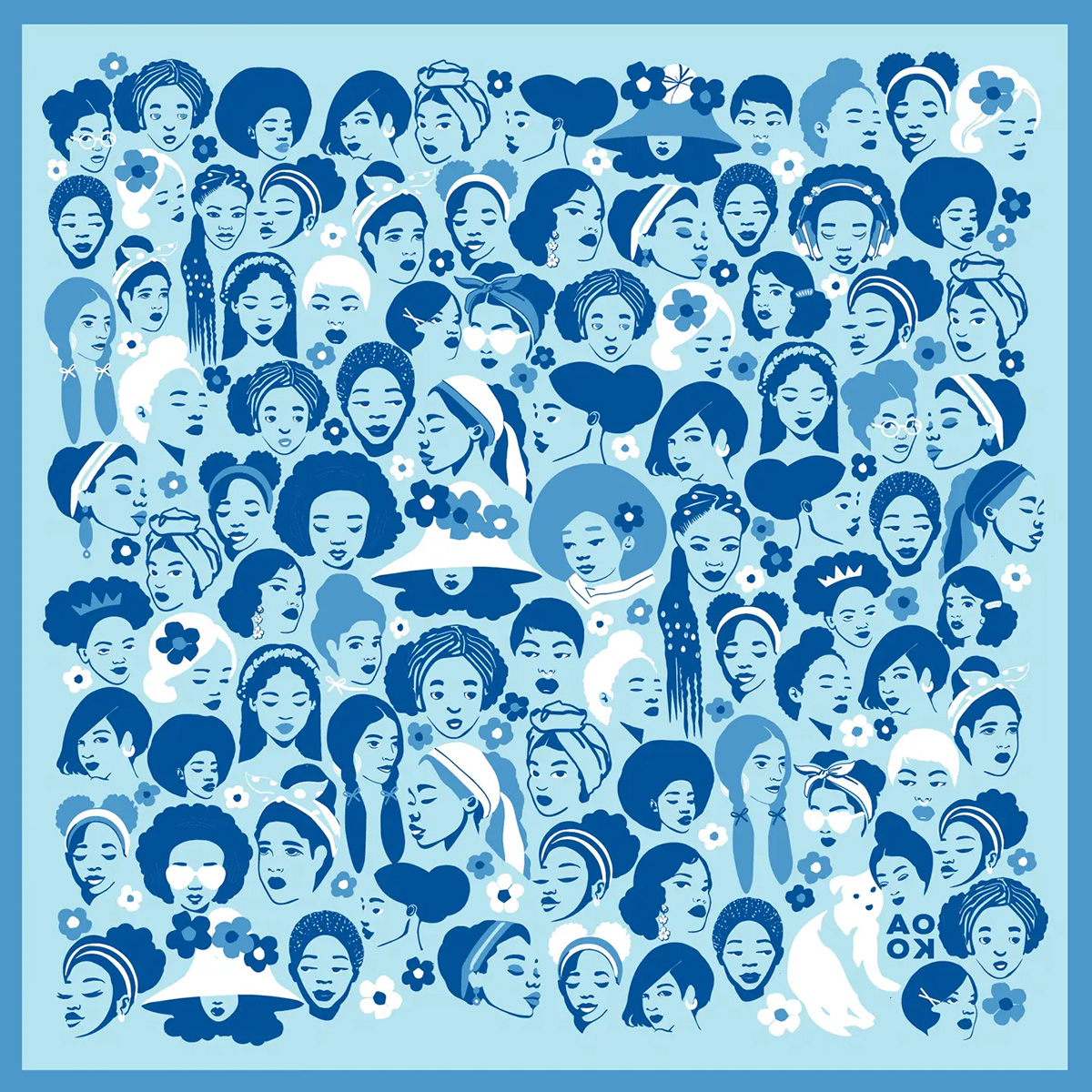
To unlock culinary creativity: The Curious Chef Gift Collection from Each Peach Market. This customizable collection of kitchen oddities — ranging from tinned fish to chili oil — is a quirky gift for the most inventive chefs. The collection is available in a Standard Santa, Extra Goodies and Super Holiday Size for up to $165. The Washington-based market, founded in 2013, permits customers to make the collection special by specifying what unique ingredients are packaged, including products made by local or LGBTQ brands. Each Peach Market offers assembly and pick up in-person at its Mount Pleasant shop and also offers local delivery and nationwide shipping via its website. ($85)
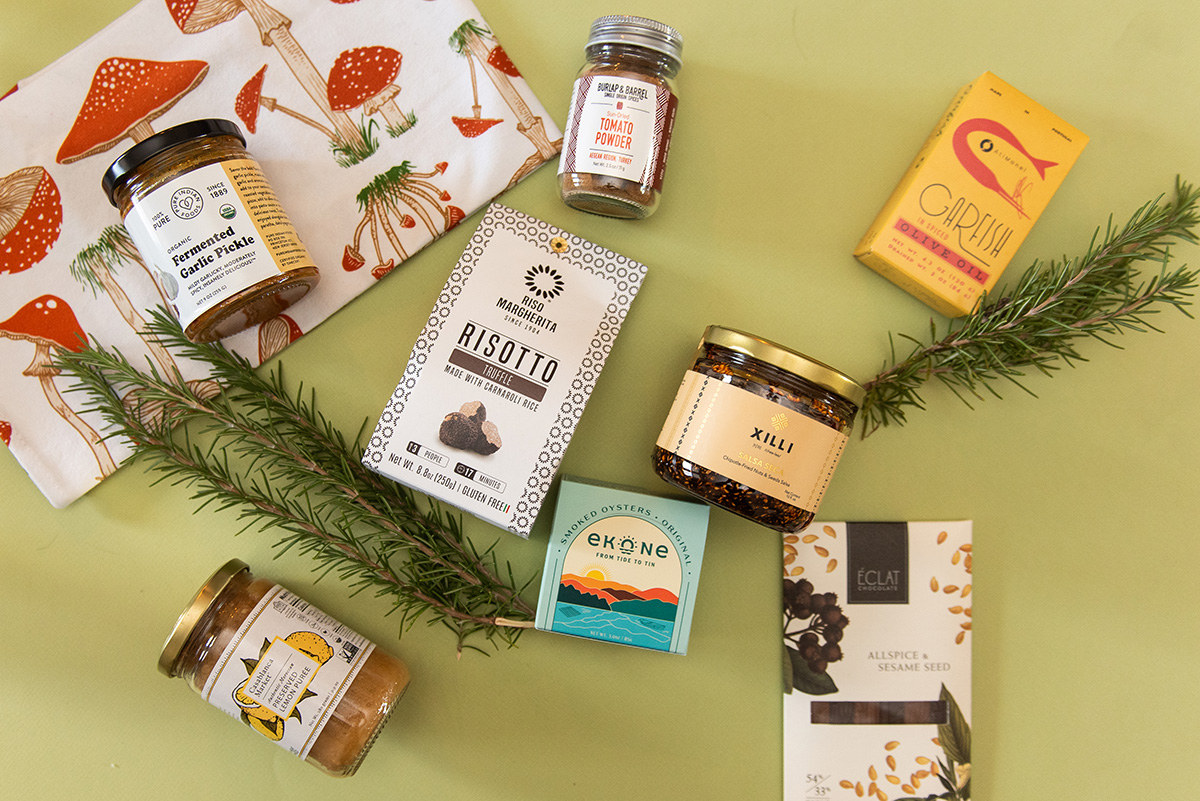
To give a touch of sweetness: The DC Landmark Chocolate Covered Oreo Holiday Cookies from Capital Candy Jar. Wrapped in a festive red bow, this box of nine cookies embraces love for Washington and the holiday season in one. Among the dark and milk chocolate covered cookies are images of the U.S. Capitol, the White House, the Lincoln Memorial, the Jefferson Memorial and festive hollies. The treat, packaged in a Hill East facility just a few blocks from the Capitol, is available for purchase online and at the DowntownDC Holiday Market. ($23.95)
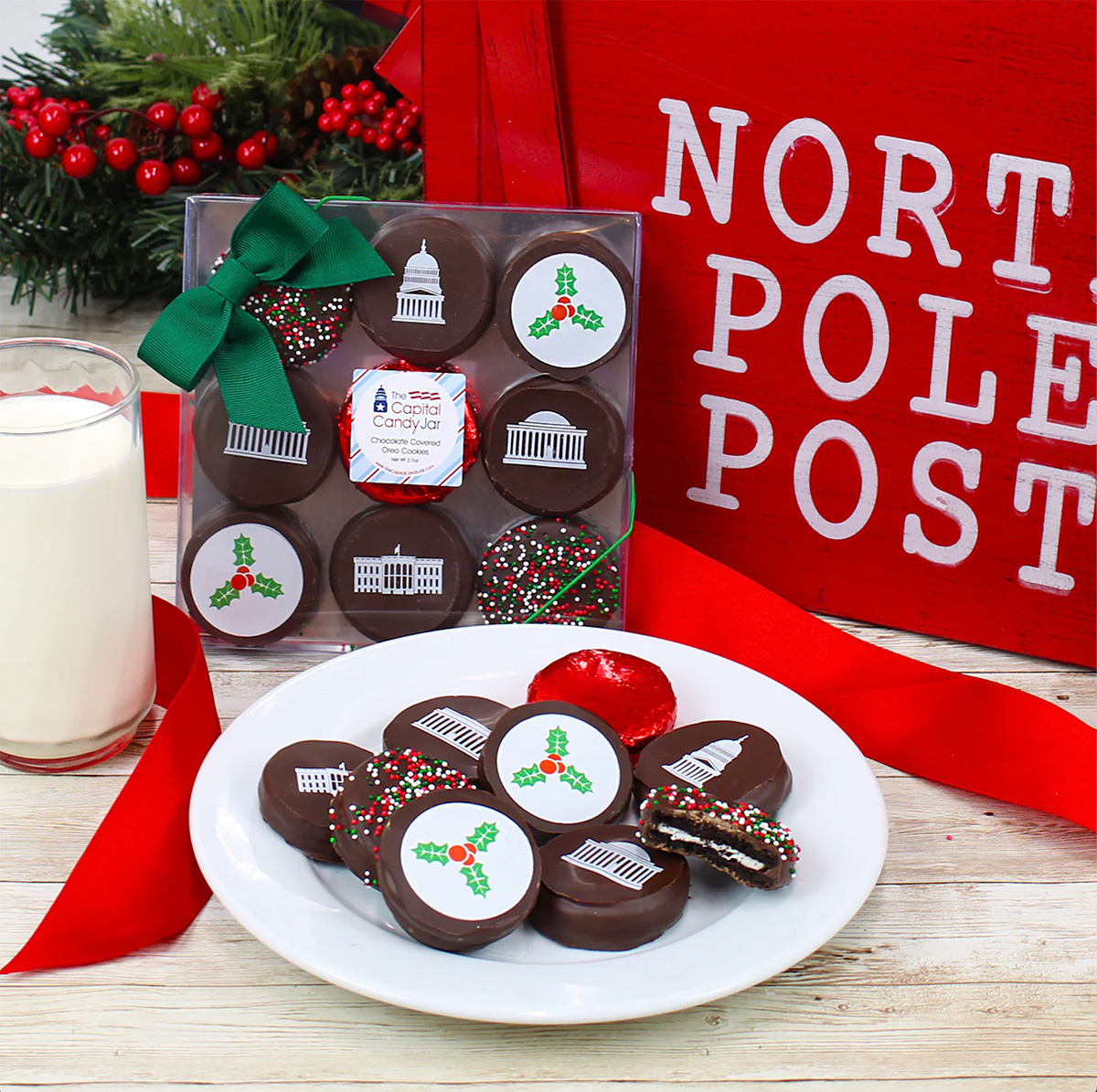
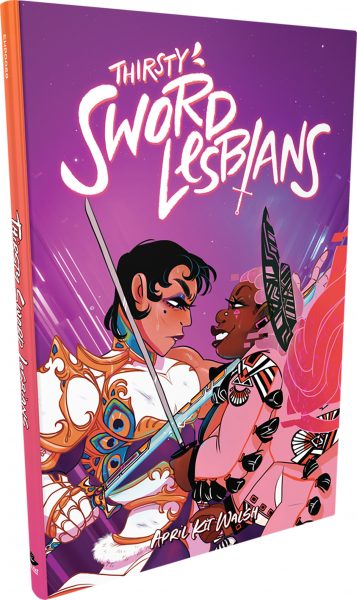
To celebrate queer gaming: Thirsty Sword Lesbians from Labyrinth Games & Puzzles. This roleplaying game embraces lesbian culture by unlocking a world of swords, romance, and battle. Ideal for group settings, the book presents a system of world building and character identities that are best brought to life by creative minds. Labyrinth, which has been a local Washington business for more than 15 years, celebrates non-digital fun through games and puzzles that connect the community. This gift is offered online and at Labyrinth’s Capitol Hill location. ($29.99)
To make a bold statement: The “Resist” T-shirt from Propper Topper. This locally screen-printed black tee features the Washington flag designed within a raised fist, symbolizing both Washington pride, and political resistance. The shirt is made exclusively by Propper Topper, a local Washington business that evolved from a hat shop to a gift store since opening in 1990. The tri-blend unisex shirt is available both for pickup at Propper Topper’s Cathedral Heights location and shipping via the online site. ($32)
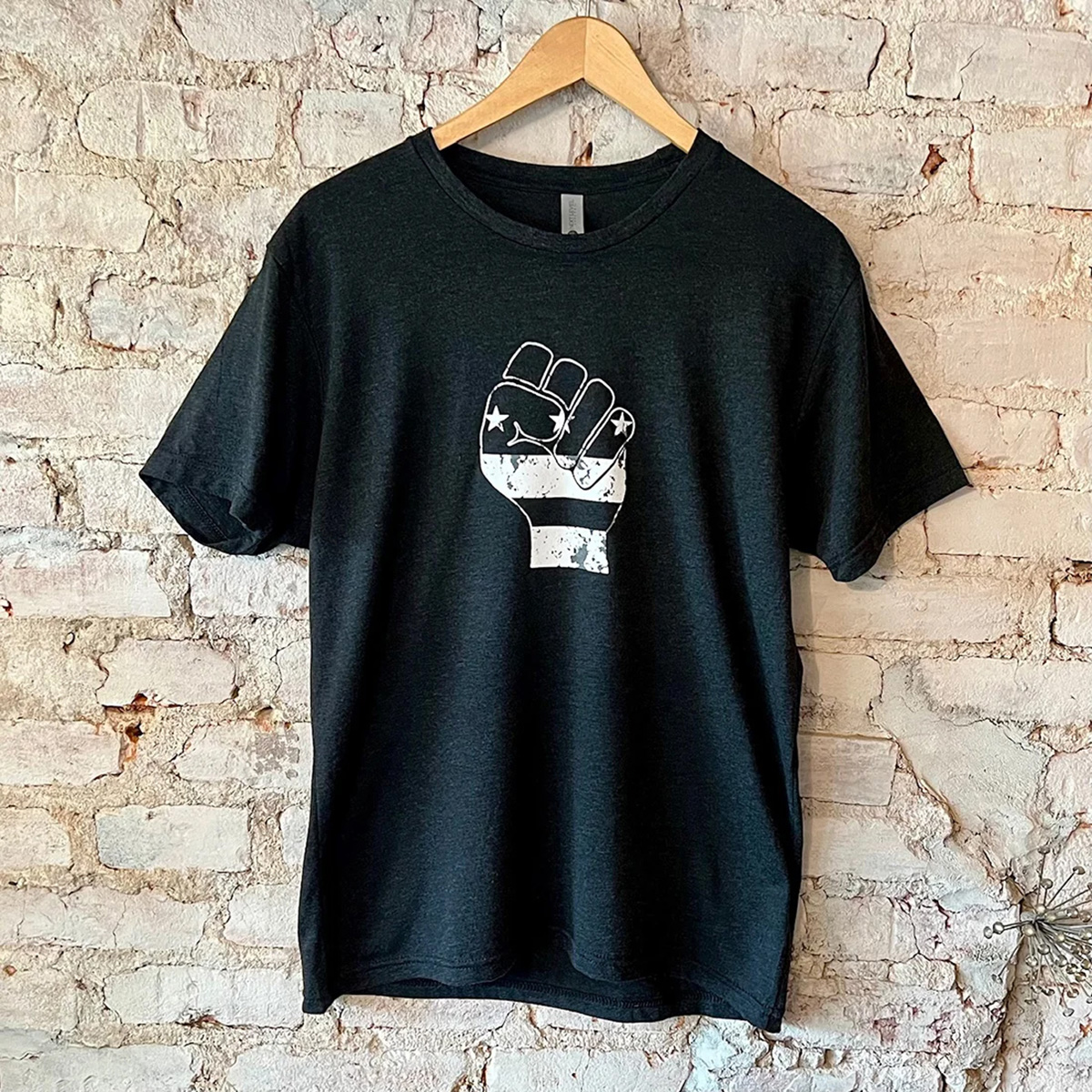
To keep it c(g)lassy: The Glass Ball earrings from Blue Moon Aquarius. Gifting can rarely go wrong when it comes to a new pair of earrings. The unique statement earrings — made of polymer clay, glass, and 18k gold plating over surgical steel — are hand cut, sanded and assembled in Washington, meaning each set is unique. Blue Moon Aquarius, a local brand, is known for its small batch jewelry and home decor designed with clay materials. Available in oxblood, hunter green, lavender, and bluestone color palettes, these earrings are available for purchase on Blue Moon Aquarius’ website and at the DowntownDC Holiday Market. ($48)
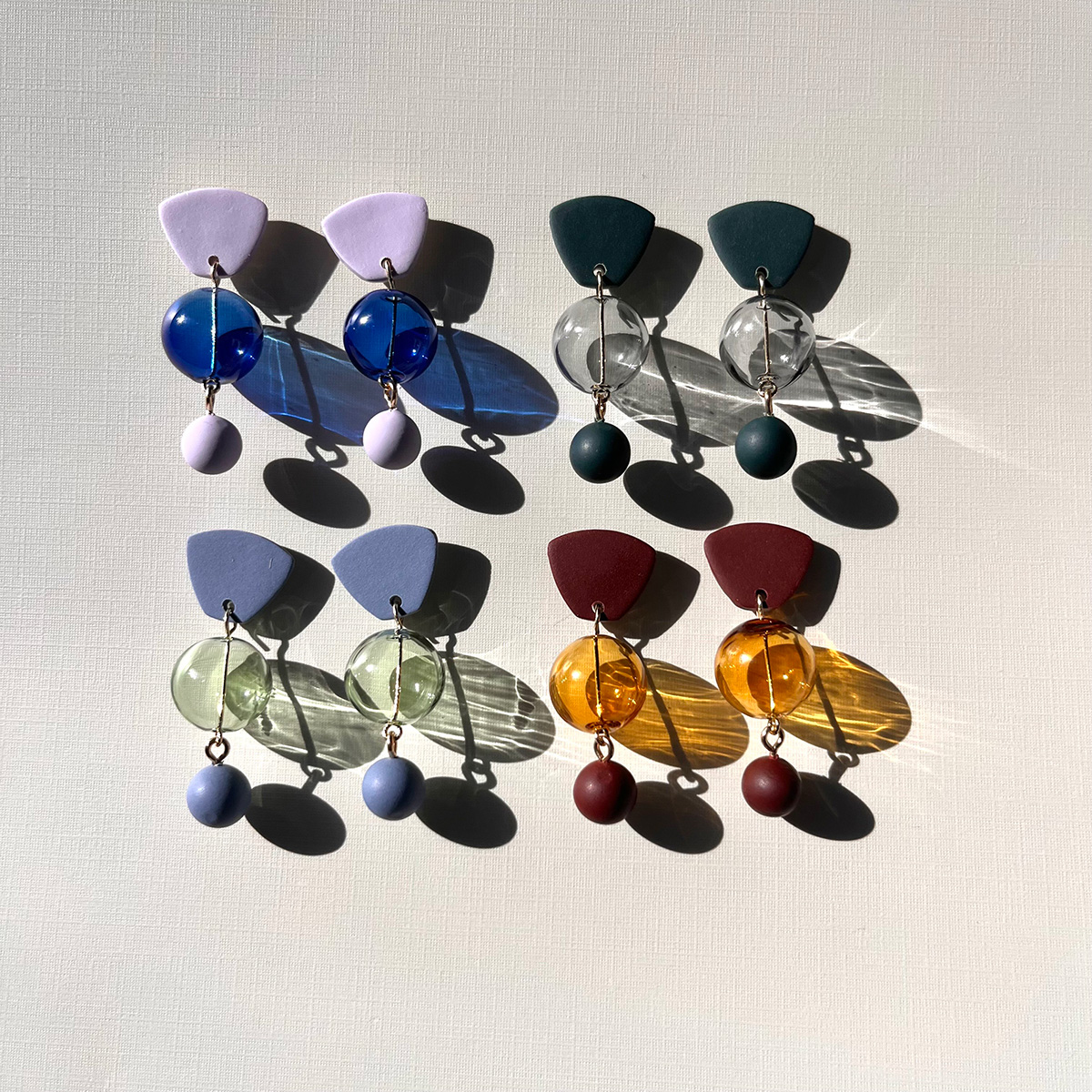
To elevate a holiday tea or charcuterie party: The Honey Flight: Tea Lover’s Selection from BannerBee. This local honey company presents the ideal gift to make cozying up with a cup of tea slightly more special. The Honey Flight contains three types of raw wildflower honey infused with fair trade Ugandan vanilla bean, chai spices, and locally sourced lemon thyme herb. The gift is also an opportunity to uplift a family company based in the Mid-Atlantic that offers all-natural, sustainable products. The flight is available online, at the DowntownDC Holiday Market or at the Arlington Courthouse and Dupont Farmers’ Markets. ($36)
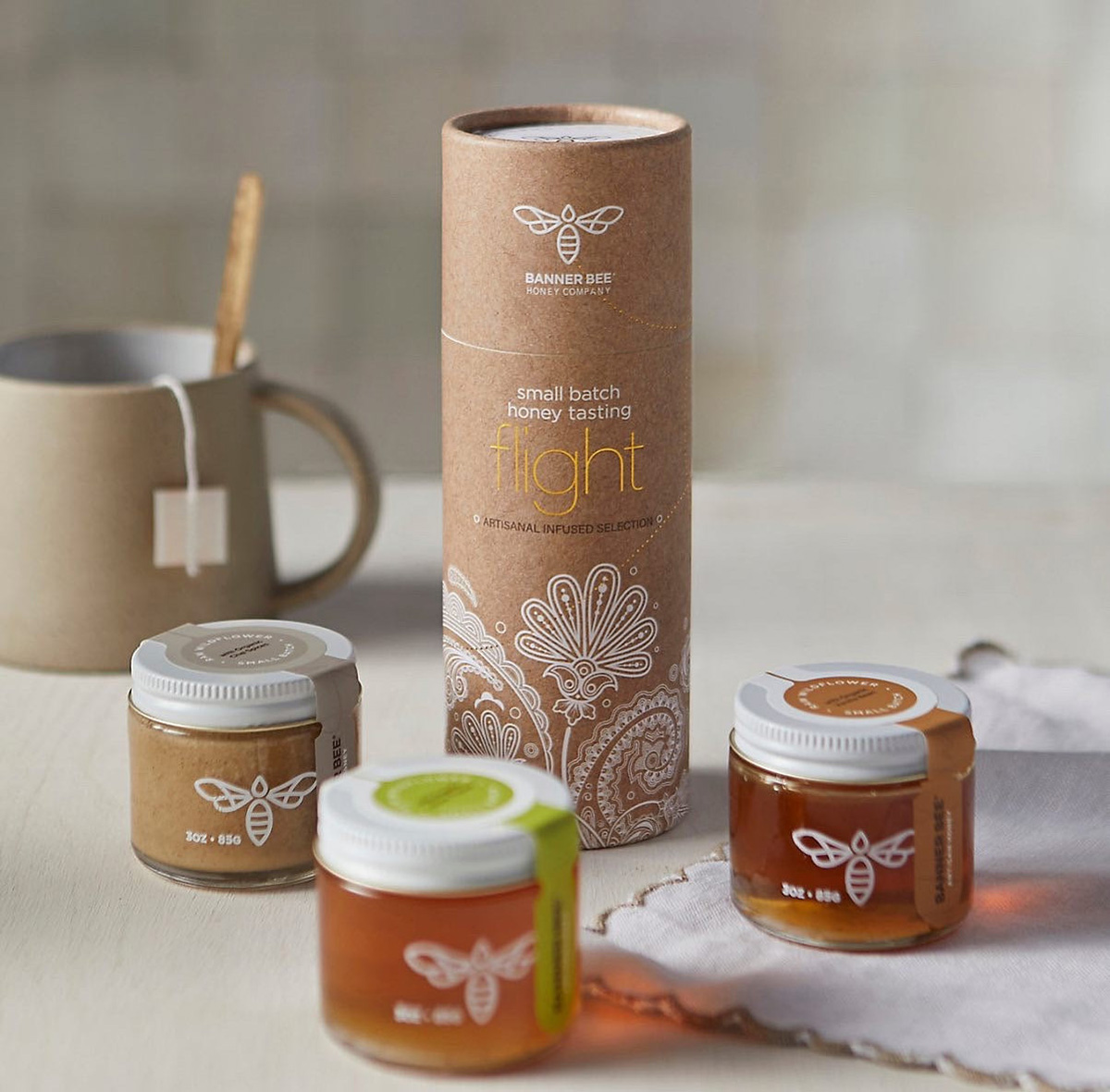
For Baltimore shoppers: If you’re in Charm City, don’t miss Balston Mercantile, opened by a gay couple in June. Their gorgeous shop in the Hampden neighborhood offers an array of unique, upscale finds, from barware and artwork to cookbooks and home decor and more. (849 W. 36th St.)
a&e features
Have yourself a merry John Waters Christmas
Annual holiday show returns to Alexandria and Baltimore
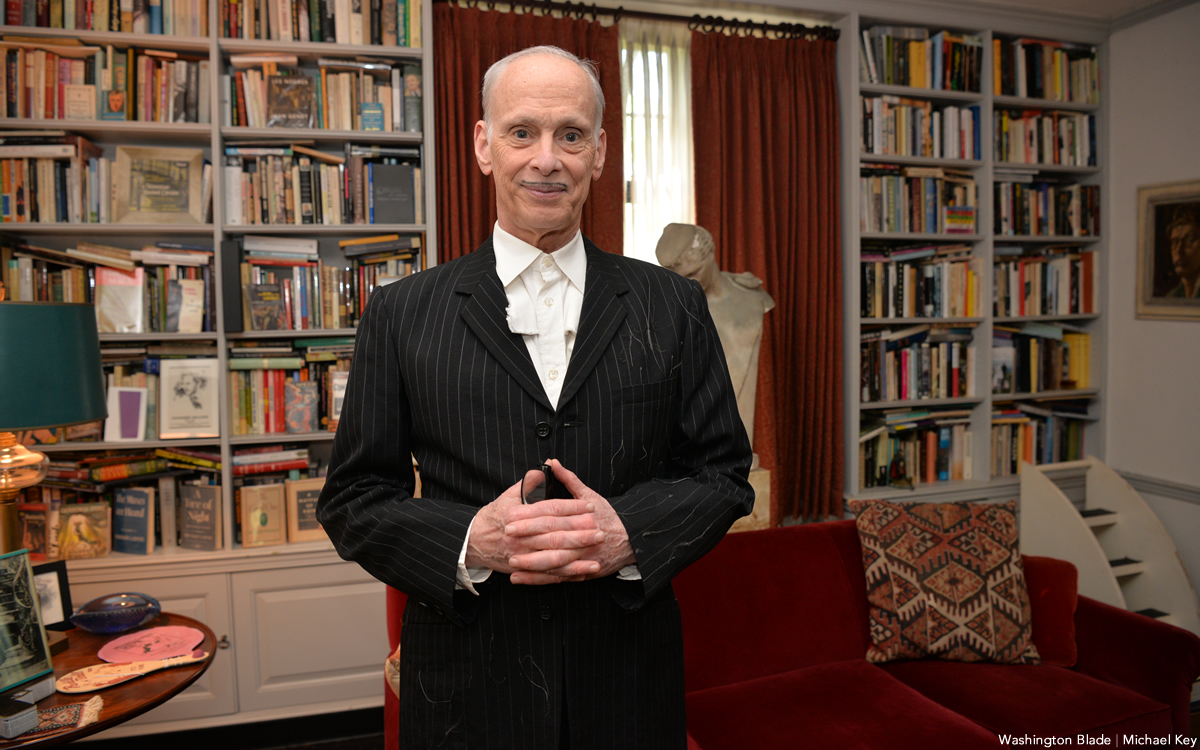
When it comes to iconic Christmas scenes in movies, none can top the tree-toppling tantrum thrown by cha-cha heels-deprived Dawn Davenport in John Waters’s fifth full-length feature “Female Trouble” from 1974. Therefore, it’s not surprising that Waters continues to make art out of Christmas, performing his spoken word Christmas tour in cities across the country. Waters has even more reason to celebrate with the release of his new red vinyl 7” single, a cover of Little Cindy’s “Happy Birthday Jesus (A Child’s Prayer)” on the A-side, and “A Pig Latin Visit From St. Nicholas” on the B-side. If you’re still looking for unique Christmas gifts, consider this record. As always, John was kind enough to make time for an interview in advance of his tour dates.
BLADE: John, in preparation for this interview with you, I went back and listened to Little Cindy’s original rendition of “Happy Birthday Jesus (A Child’s Prayer)” on your “A John Waters Christmas” CD.
JOHN WATERS: One thing I did, if you notice, I make the same stumble in my recording that she did in the original.
BLADE: It sounded to me like she got choked up.
WATERS: No, I think she just stumbles over a word, so I stumbled over the same word. It’s appropriation, insanely.
BLADE: Is this a song you first became aware of in your youth or when you were an adult?
WATERS: When I was doing the Christmas album, I had this friend named Larry Benicewicz. He was kind of my idea man with music. He knew every single old record. I would say to him, “Weird Christmas songs,” when we were doing a soundtrack, or a song about bears, or a song about this, and he would give me all these tapes. It was one of the ones he played for me. A lot of the songs I put in my movies and on my records, I did know as a kid. I did not know this one, but I immediately embraced it. I don’t think it’s campy. I think it really is spiritual in a weird way. My doing it makes it a novelty record. I am really for novelty records, and there aren’t any anymore. Why was there not a COVID novelty record? That’s insane. The dance “The Bug” that’s on the “Hairspray” soundtrack would be perfect for COVID.
BLADE: The thing that struck me was that for a Christmas song in the voice of a child, a kind of death pall hangs over it, with lines like, “If I was good you’d let me live with you” and “they nailed you to the cross, they wanted you to die.”
WATERS: All of it! When I see children at midnight mass kneeling in front of a nude man nailed to a cross, I feel like I’m at The Eagle! It is S&M, it’s creepy. I took the same cover (photo) from her record to parody and put my face on it. The same thing I did with The Singing Dogs last year when I covered (their version of) “Jingle Bells.” I’m really into novelty records. I love them and I’m trying to bring them back. I don’t expect anybody to ever play these records. Even The Singing Dogs one said on it, “Please do not play this record” [laughs]. And the flipside, the Pig Latin version, is almost impossible to listen to.
BLADE: I’m so glad you mentioned that. “A Pig Latin Visit From St. Nicholas” reminded me of the lost art of speaking in Pig Latin. I also recall watching the PBS series “Zoom” as an adolescent and learning to speak “ubbi dubbi,” a distant relative of Pig Latin. Do you think that the time is right for a Pig Latin or ubbi dubbi revival?
WATERS: Here’s the thing, I never could pick up any language, except Pig Latin. I’ve been in every foreign country. Foreign countries have given me money to learn to speak the language. I can never do it! But Pig Latin…my parents and other parents in the ‘50s spoke Pig Latin so kids couldn’t understand what they were saying. Then my mother taught it to me, and I used it. The hardest take to shoot in “Pink Flamingos” was not eating the dog shit. It was when the cast skipped, in one take, saying “E-way, are-yay e-they ilthiest-fay eople-pay in-hay e-they ole-hay ide-way orld-way.” We’re the filthiest people in the whole wide world in Pig Latin. We had to do so many takes so they could do it once without screwing it up. In “Polyester,” Edith (Massey) answers the phone, “ello-hay.” I did a photo piece where it was all subtitled in Pig Latin. Like “osebud-Ray” (from “Citizen Kane”) or in “Streetcar,” “ella-Stay!” [Laughs] All the iconic dialogue translated into Pig Latin. My assistant who helped me do it, had never heard of Pig Latin. She really got good at it because she lived in many foreign countries and can pick up languages. But it’s not that easy to do it correctly and read it. Your computer will translate into Pig Latin.
BLADE: AI understands Pig Latin?
WATERS: I guess that’s AI. It wasn’t 100% right, but it was close. I can speak it if I look at it, but just do a bit at a time. It was a challenge that no one would possibly care about or want to do.
BLADE: I think you pulled it off very well.
WATERS: If you want people to leave on Christmas morning, you put it on. That’s how you get your guests to leave. It’s time to go.
BLADE: Ood-gay i-bay! How did your relationship with record label Sub Pop, which released 2021, 2022, 2024, and new 2025 holiday singles, come about?
WATERS: I believe the first thing I did for them was “Prayer to Pasolini.” They came to me through Ian Brennan. He’s won a couple Grammys for World Music, but he is also is one of my agents who does the Christmas tour and a lot of my shows, anything with music. He helped me arrange each one of the songs. He had a relationship with Sub Pop. It was perfect. My friends in Baltimore, (the band) Beach House, have had huge success.
BLADE: That’s right, they’re on Sub Pop!
WATERS: Yes! I’m happy to be on it. I’ve even been to the warehouse and posed for pictures like Jackie Suzanne used to do.
BLADE: Is there any chance that “A John Waters Christmas” might be reissued on vinyl by Sub Pop?
WATERS: No. It’s such a nightmare to get the rights and to renew them. You have to find the publisher and the writer, and they usually hate each other. It doesn’t matter if it’s obscure or famous, it’s hard to get. You have to make the deal. The singer doesn’t get anything unless they play it on the radio. It would be so complicated legally, and there would be such a [laughs] tiny audience for it. I hope it will come out again. The same thing with the one for Valentine’s Day. I had two of them that did quite well when they came out; “A Date With John Waters and “A John Waters Christmas.” The “John Waters Christmas” album is still the soundtrack that plays whenever I’m doing my spoken word Christmas show as people are entering the theater.
BLADE: Aside from your annual Christmas show tour, what else do you do for the holidays now, and are there any traditions that you’ve carried over from your family?
WATERS: Certainly! I have two sisters, my brother’s widow, and me, so there are four and we take turns each year to have the Christmas dinner. Mine was last year. An entire sit-down dinner. Mom’s China, the silverware, the entire full dinner. It’s pretty traditional. I don’t have a Christmas tree, but I do decorate the electric chair from “Female Trouble.” That is a tradition in my family. We do have Christmas decorations, but they’re usually weird ones that fans sent me. I have one with Divine knocking over the Christmas tree, and the Christmas tree lights up, all sorts of amazing things. There is definitely a tradition here that might be a little altered, but it is definitely a tradition. I used to have a giant party every year, but COVID ended that. I still wouldn’t want 200 people in my house breathing right now.
BLADE: I was looking at your tour schedule and wondered if there are any new cities in which you’ve never performed the John Waters Christmas show that have been added to this year’s schedule?
WATERS: I don’t think there’s a city in America in which I haven’t done one show! The only places I haven’t been to are Hawaii and Alaska. I could do it there, but it’s too long on a tour. I can’t think of a city I haven’t played in in America over the last 50 years. The Christmas show is completely different every year. It doesn’t matter if you saw it last year.

Some gifts scream practical, others whisper luxury, and a few flat-out blur the lines. From cocoa that feels ceremonial to a cologne that linger like a suggestive smirk, this year’s ultimate gift picks prove that thoughtful (and occasionally naughty) presents don’t have to be prosaic. Welcome to your holiday cheat sheet for festive tangibles that get noticed, remembered, and maybe even result in a peck of gratitude planted under the mistletoe. Consensually, of course.
Amber Glass Champagne Flutes
Pop the champs – but make it vintage. These tulip-shaped stunners in amber-tinted glass bring all the Gatsby vibes without the Jazz-age drama. Whether you’re toasting a milestone or celebrating a Tuesday, their seven-ounce capacities and hand-wash-only care make ‘em as practical as they are pretty. Pair with a thoughtful bottle of bubs and gift with a glittering wink. $18, NantucketLooms.com
Disaster Playbook by Here Comes the Apocalypse
Because the end of the world shouldn’t be a solo act, this spiral-bound guide is your step-by-step roadmap to surviving and thriving when everything else goes sideways, which might be sooner than you think. Packed with checklists, drills, and a healthy dose of humor, it’s like a survival manual written by your most prepared (and slightly snarky) friend. Whether you’re prepping for a zombie apocalypse or, more realistically, REVOLUTION!, this playbook’s got your back. $40, HereComesTheApocalypse.com
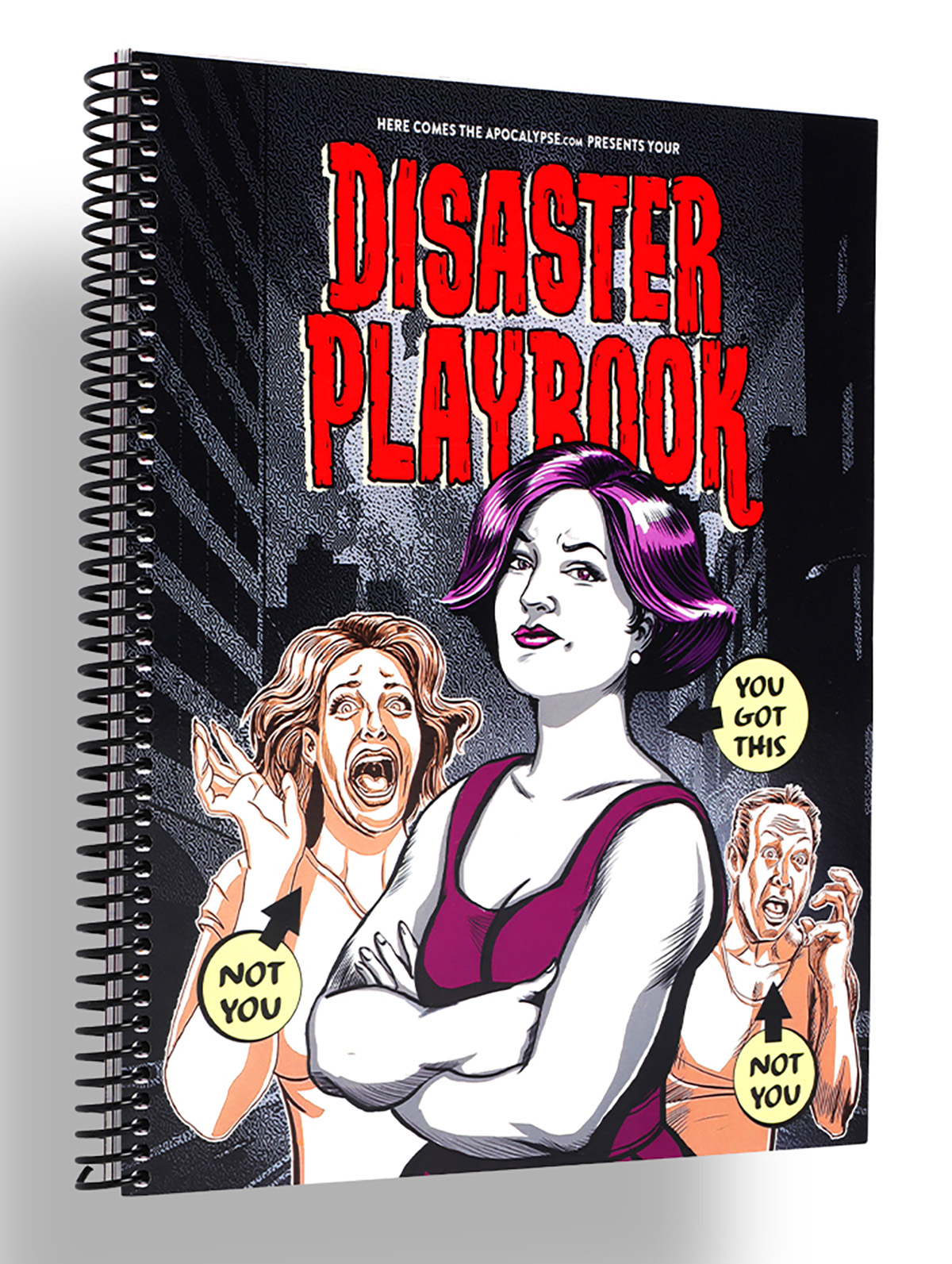
Wickless Vulva Candles
Bold, luxurious, and completely flame-free, CTOAN’s wickless candles melt from beneath on a warmer, releasing subtle, sophisticated fragrances, like sandalwood or lavender. The vulva-shaped wax adds a playful, provocative element to any space –perfect for a bedroom, living room, or anywhere you want elegance with an edge. A gift that celebrates form, intimacy and self-expression, no fire required. $39, CTOANCO.com
Villeroy & Boch Royal Classic Christmas Collection
Every meal is a mini celebration – with whimsy at every place setting – in Villeroy & Boch’s Royal Classic festive dinnerware collection that hits all the right notes. Made from premium German porcelain, it features nostalgic little toys, nutcrackers, and rocking horses in delicate relief, giving your holiday spread a playful but refined twist. Dishwasher- and microwave-safe, it’s luxe without the fuss. Gift a piece to a special someone, or start a collection they’ll use (and show off) for years to come. $22-$363, Villeroy-Boch.com
Greenworks Electric Lawnmower
You a ’hood queen who considers lawn care performance art – or just wants to rule the cul-de-sac in quiet, emission-free glory? Greenworks’ zero-turn electric mower has the muscle of a 24-horsepower gas engine but none of the fumes, drama or maintenance. Six 60V batteries and a 42-inch deck mean you can mow up to two-and-a-half acres on a single charge – then plug in, recharge, and ride again. It’s whisper-quiet, slope-ready, and smooth enough to make you wonder why you ever pushed anything besides your queer agenda. The perfect gift for the homeowner who loves sustainability, symmetry, and showing off their freshly striped yard like that fresh fade you get on Fridays. $5,000, GreenworksTools.com
Molekule Air Purifier
For the friend who treats their space like a sanctuary (or just can’t stand sneezes), the Molekule Air Pro is magic in motion. Covering up to 1,000 square feet, it doesn’t just capture allergens, VOCs, and smoke – it destroys them, leaving your air feeling luxury-clean. FDA-cleared as a Class II medical device, it’s serious science disguised as modern design. Gift it to your city-dwelling, pet-loving, candle-burning friend who likes their living room as pristine as their Instagram feed. $1,015, Molekule.com

Cipriani Prosecco Gift Set
Effervescent with stone-fruit sweetness and a touch of Italian flair, the Cipriani Bellini & Prosecco gift set brings brunch-level glamour to any day of the week. The Bellini blends rich white-peach purée with sparkling wine, while the dry ’secco keeps things crisp and celebratory. Pop a bottle, pour a flute, and suddenly winter weeknights feel like a party – even with your pants off. $36, TotalWine.com
Woo(e)d Cologne
British GQ recently crowned Woo(e)d by ALTAIA the “Best Date Night Fragrance,” and honestly, they nailed it. Confident without being cocky – smoky gaïac and Atlas cedarwood grounds the room while supple leather and spicy cardamom do all the flirting – it’s a scent that lingers like good conversation and soft candlelight. Gift it to the one who always turns heads – or keep it for yourself and let them come to (and then on) you. $255, BeautyHabit.com
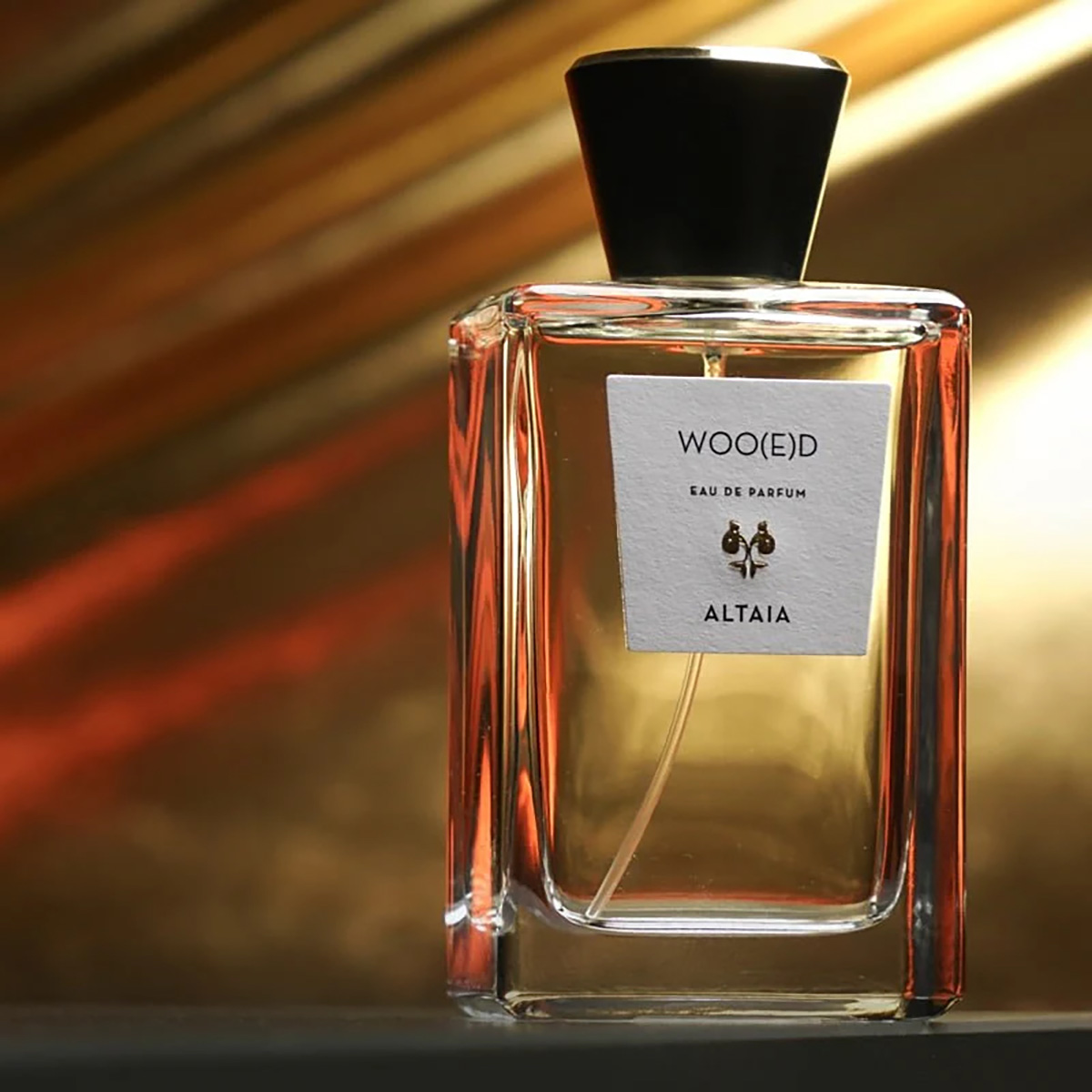
Lococo Cocoa Kit
Keep the run-of-the-mill mugs in the cabinet this Christmas and pull out Lococo’s handcrafted Oaxacan versions that demand you slow down and sip like it matters. Paired with a wooden scoop, rechargeable frother, and Lococo’s signature spice hot-chocolate blend (vegan, gluten-free, with adaptogenic mushrooms), this holiday kit turns Mexi-cocoa into a mini ritual you’ll look forward to. Perfect for anyone who loves a little indulgence with a side of ¡A huevo! energy.
Manta Sleep Mask
Total blackout, zero pressure on the eyes, and Bluetooth speakers built right into the straps, this ain’t your mama’s sleep mask — but it could be. The Manta SOUND sleep mask features C-shaped eye cups that block every hint of light while ultra-thin speakers deliver your favorite white noise, meditation, or late-night playlist straight to your ears. With 24-hour battery life, breathable fabric, and easy-to-adjust sound, it turns any bed (or airplane seat) into a five-star sleep suite. Perfect for anyone who treats shut-eye like an art form (or just wants to escape their roommate’s late-night bingin’ and/or bangin’). $159, MantaSleep.com

Shacklelock Necklace
Turn the industrial-chic vibe of a shackle into a sleek statement. Mi Tesoro’s platinum-plated stainless-steel necklace sits on an 18-inch wheat chain, featuring a shackle-style latch pendant that’s waterproof, tarnish-free, and totally fuss-les. Beyond style, it nods to a classic gesture in the queer leather community: replacing a traditional Master lock with something elegant to quietly signal belonging to someone special. Wear it solo for a minimalist edge or layer it like you mean it; either way this piece locks in both your look and your intentions. $90, MiTesoroJewelry.com
Parkside Flask Mojave Edition
Wine nights get a desert glow-up with Parkside’s limited-edition 750-milliliter all-in-one flask draped in sun-washed bronze and badland hues like sage, sand, and terracotta – with magnetic stemless tumblers that snap on for effortless shareability. It keeps your vino chilled for 24 hours, pours without drips (no tears for spilled rosé, please), and even lets you laser-engrave your own mantra or inside joke. Perfect for picnics, surprise rooftop clinks, or gifting to your favorite wine (or desert) rat. $149, HighCampFlasks.com
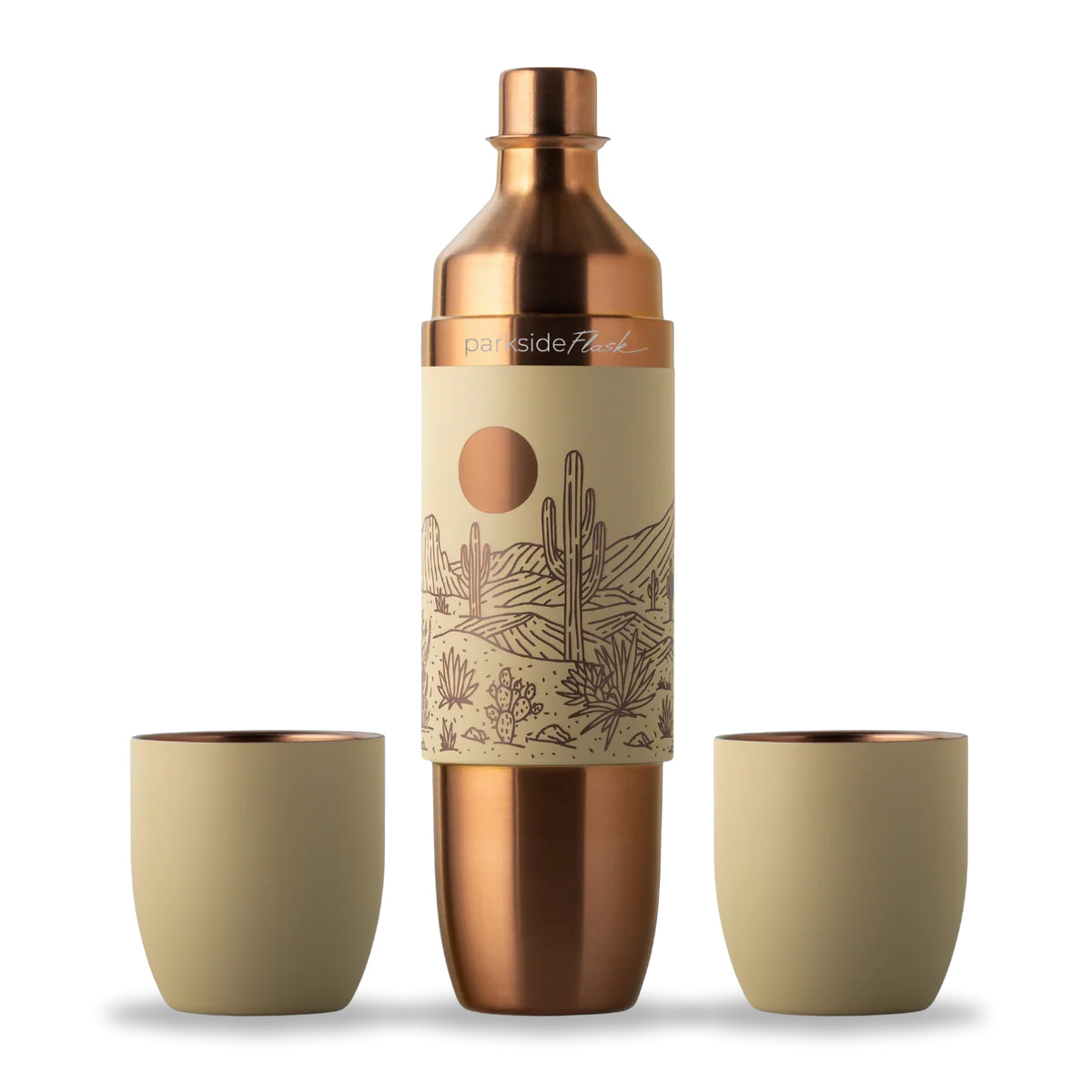
Mikey Rox is an award-winning journalist and LGBT lifestyle expert whose work has published in more than 100 outlets across the world. Connect with him on Instagram @mikeyroxtravels.
-

 District of Columbia5 days ago
District of Columbia5 days agoNew queer bar Rush beset by troubles; liquor license suspended
-

 The White House5 days ago
The White House5 days agoHHS to restrict gender-affirming care for minors
-

 The White House4 days ago
The White House4 days ago‘Trump Rx’ plan includes sharp cuts to HIV drug prices
-

 The White House4 days ago
The White House4 days agoEXCLUSIVE: Democracy Forward files FOIA lawsuit after HHS deadnames Rachel Levine



